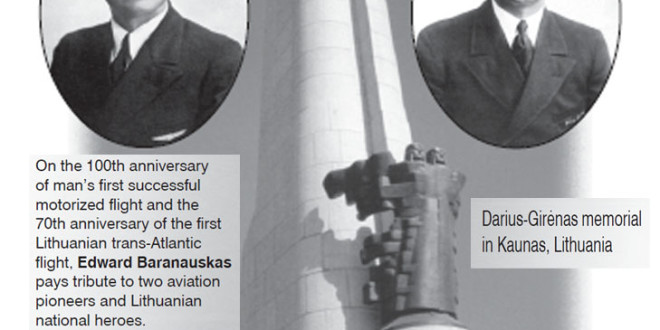By Edward Baranauskas
Remembering Darius-Girėnas Memorial 1933-2003
SEVENTY YEARS AGO, ON July 15, 1933, two Lithuanian American flyers, Stephen (Steponas) Darius and Stanley (Stasys) Girėnas, took off from Floyd Bennet Field in Brooklyn, New York at 6:24 A.M. EDT, on their attempted nonstop trans-Atlantic flight to Kaunas, at that time the provisional capital of the land of their birth — Lithuania.
Their single-engine monoplane, named “Lituanica,” unfortunately did not reach its final destination, and 37 hours and 11 minutes later crashed in a forest in Soldin, which was then part of Germany. They were only 404 miles short, or less than four hours of flying time, from reaching Kaunas. This was the second longest distance flight on record in the history of aviation at that time What was the cause of this tragedy? Some of the press, at home and abroad, blared the news that the Nazis may have shot down the “Lituanica” because it strayed too close to a concentration camp. This was sensational journalism, in my opinion. Because it could not be proven conclusively, it should be characterized as pure speculation. My story perhaps may clear this “mystery.” I would like to start the odyssey of the “Lituanica” from the time it left Chicago.
A large crowd gathered at Chicago’s Municipal (now Midway) Airport on May 7 to wish both pilots good luck, and then they flew to Newark Airport in New Jersey. After being honored by the Lithuanian community of Newark, they arrived the next day, May 8, at Floyd Bennet Field, New York’s Municipal Airport at that time. Darius and Girėnas were greeted by members of the press, and the airport’s manager who invited them to be guests of the City of New York. Darius and Girėnas stayed at the Half Moon Hotel in Coney Island, and Hangar Number 7 would be the home for “Lituanica,” all at no charge. All of the trans-Atlantic fliers were treated in the same courteous manner.
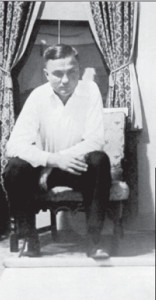
What had been an anticipated short time until takeoff, the pilots’ departure was delayed until the middle of July. The biggest problem was that the U.S. Department of Commerce had to give their approval for the flight, and, in addition, they had to receive authorization from the countries on their flight path, in the event of an unplanned emergency landing en route. All of this paperwork was time consuming. The days dragged on into weeks, and by now the flyers were getting frustrated and restless. They were willing to take off without authorization from anybody. However, bad weather along their planned route prevent ed them from taking any action.
While waiting, they were studying the charts. Even though the flyers did not take parachutes, and “Lituanica” was not equipped with radios due to weight considerations and the lack of funds, it did have all the instruments needed for blind flying. Darius planned to use three methods of navigation: dead reckoning, direction and time, and astronomical-celestial.
Dr. James H. Kimball, manager of the U. S. Weather Station in Battery Park, New York, boosted their morale with fatherly advice, telling them that while public reaction to postponing the flight is important, much more important is the success of their flight. If they would ignore the weather reports and would take a chance, they could destroy themselves. And, sad to say, as it later turned out, that is exactly what happened.
“Lituanica,” on June 15, had good company in Hangar Number 7 with the arrival of Wiley Post, a famous air pioneer, with his airplane, the “Winnie Mae.” His planned flight around the world was delayed because of unfavorable weather conditions, and, just like Darius and Girėnas, had to wait until conditions improved.
On July 14, at 6 A.M., the two pilots had a meeting with Col. Paul Žadeikis, Lithuanian Consul General in New York, at Hangar Number 7 and hinted that they may takeoff the next morning because of the favorable weather reports they had just received. They promised to confirm this around midnight.
That evening at 11 P.M., Victor Yesulaitis, the aircraft mechanic who had been taking care of both the “Lituanica” and the “Winnie Mae,” informed the pilots at the hotel, by phone, that Wiley Post would be taking off at dawn the next morning. Hearing the good news, the pilots asked to have a bag of letters taken to the Brooklyn Post Office to be postmarked, and then put on board the airplane. Both then retired to get some rest, but how much rest could they possibly get, at that late hour, with so much excitement and anticipation surrounding them?
That phone call from Victor Yesulaitis triggered a series of events that put Darius in the position of having to make the most difficult decision that would affect both him and Girėnas.
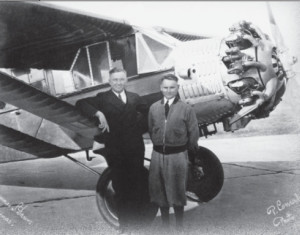
Darius and Girėnas arrived at the airport about 4:30 in the morning, and walked up to Wiley Post to wish him good luck. In the meantime, the “Lituanica” was being fully loaded with fuel, and the necessary items to sustain the pilots during the flight.
Major J. Nelson Kelly, commandant of Floyd Bennet Field, asked the pilots why was there so much activity surrounding the “Lituanica.” It was for a load test, they replied, because flying conditions seemed ideal for that. They didn’t dare tell him what the real reason was, because Darius and Girėnas still hadn’t received the approval from the U. S. Department of Commerce to fly to Europe. If they would have told him of their true intentions, the pilots may have been prevented from leaving.
John P. V. Heinmuller, chief timer of the National Aeronautical Association and the Federation Aeronautique Internationale, noted the following in his book, Man’s Fight to Fly:
“An hour before Wiley Post planned to take off, a cable came from Paris warning that bad weather was developing over Europe, that a real storm was gathering speed and force in southern Europe, and was moving northward towards Russia. Heinmuller discussed this latest report with Wiley Post, who showed no concern, because, according to his calculation, with the ‘Winnie Mae’ averaging a speed of around 180 miles an hour, he would be in Berlin within 24 hours and thus escape the bad weather.”
The author then tried to explain to Darius and Girėnas, that their Bellanca, flying at only 100 or 125 miles an hour at the most, would certainly be caught in the bad weather long before they could get to their objective. Despite all efforts to convince them to do otherwise, they took off, leaving only a little over an hour or so after Post.
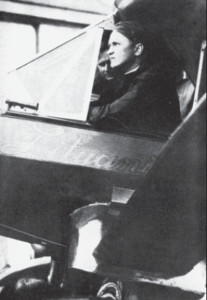
Why did the pilots ignore this advice? If they changed their flight plans now, then it was possible that the next day’s weather over the Atlantic might not be so favorable, and perhaps not for another several weeks. They were frustrated, having waited for two months as it was, and wanted to fly without any more delays. There was another point to consider. How accurate were those meteorologists with their long-range forecasts in the early 1930s? Was it possible for weather conditions to improve before they reached Kaunas? Besides, the pilots had told the field’s commandant that they were preparing for a load test because the weather was ideal, and what excuse could they give for not flying? Still another point they probably considered was the mailbag on board which was full of letters postmarked July 15, 1933. Darius and Girėnas decided to gamble.
Wiley Post wanted to circle the world in six days. He was the first to make a non-stop flight from New York to Berlin, and then took off for his next stop at Novosibirsk (Siberia), but was forced to land at Koenigsberg (East Prussia) because of electrical storms, the same ones that forced Darius and Girėnas to change direction. It must be pointed out that the “Winnie Mae” had the latest equipment which “Lituanica” did not have, such as a variable pitch propeller, a radio compass (ADF) and an automatic pilot.
“Lituanica” was sighted over a town in northern Germany late in the evening of July 16 heading northeast. Since the airplane was painted a bright orange color, this probably made it easier to identify. As they approached the Polish border they encountered stormy weather and heavy rains, and this forced them to change course. Flying now in a southwesterly direction, they were not far from a Nazi concentration camp, 120 miles northeast of Berlin. They continued in that direction and approached the town of Soldin, apparently looking for a suitable landing place. It is entirely possible that when they noticed a meadow beyond the forest’s edge, they decided to take a chance and set down there.
A farmer living near the forest said he heard an airplane flying at low altitude, and then a resounding crash. Because of the bad weather, the farmer went back to sleep. He said it was raining, foggy, with low clouds, and very dark.
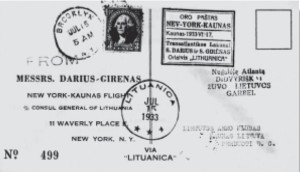
The smashed remains of “Lituanica” were found the next morning by some peasant women as they went to gather berries or mushrooms. Darius’ body was lying beside the wreckage, while the body of Girėnas was still in the cockpit. A flashlight was still shining and one of the watches was stopped at 36 minutes past midnight, probably local time, indicating the possible time of the accident.
German troopers arrived at the scene, which was about seventy miles northeast of Berlin, and stood guard at the crash site to prevent looting, but not before “souvenir hunters” carried away some parts of the plane. The caskets with the bodies of the pilots, their personal belongings, and the mailbag were flown to Kaunas aboard a trimotor “Deruluft” airplane with the cooperation and help of the Germangovernment. The Lithuanian Postal Service delivered the mail to the addressees. The wreckage of the “Lituanica” was also brought to Kaunas and deposited in the Vytautas the Great Museum for permanent exhibition.
A grief-stricken nation searched for answers to the possible cause of the accident.
Two boards of inquiry were set up by the Lithuanian government, and one of them consisted of Medical Professor Doctor Kazys Oželis and Professor of Anatomy Jurgis Žilinskas. They thoroughly examined the remains of the pilots; the results were signed by both and submitted to Lithuanian Prime Minister Juozas Tūbelis.
Following the end of World War II, Dr. Oželis resided in Chicago. After reading in one of the Lithuanian language newspapers in the United States where a writer claimed that the pilots had bullet wounds, he wrote a statement which he sent to the Lithuanian Legation in Washington, D.C. on February 24, 1959, disputing that story. Here is a summary of what he wrote:
“After the tragic deaths of Darius and Girėnas, rumors spread in Lithuania that the pilots perished from German bullets, and not because of the storm.
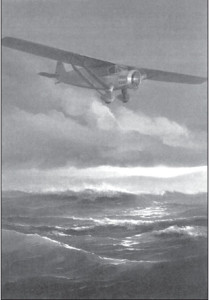
The Lithuanian government took steps to learn the cause of death of Darius and Girėnas. When the bodies were taken by plane from Germany to Kaunas, they were brought to the Forensic Medicine Institute in Kaunas to find out if there were any signs of wounds made by bullets.
Juozas Tūbelis, Prime Minister of Lithuania asked Professor of Anatomy Jurgis Žilinskas and Forensic Medicine Professor Dr. Kazys Oželis to examine the bodies of the pilots, and to describe and submit all injuries found to Prime Minister Tūbelis.
Dr. Oželis was summoned to Kaunas from Palanga where he was vacationing. The examination was started right away. The bodies were affected by the summer temperatures and started to decay. The examination was difficult because the bodies had to be saved for embalming. The doctors had to examine every injury on the skin, and the bones were checked by Xray. There were found extensive injuries, such as crushed bones, torn muscles, and injuries made by protruding bones. There were never found any signs that would cause suspicion that the pilots were shot. The examination took three days. Everything was described in detail, and both doctors unanimously stated that there were no wounds in the bodies made by bullets.
The documents were handed to Prime Minister Juozas Tūbelis. The bodies were then submitted for embalming. Dr. Oželis never heard from Prof. Žilinskas, who was in charge of embalming, neither from anyone else, that there were found traces of bullets in the bodies. Also, Dr. Oželis never heard that the Foreign Minister of Germany ever pressed the Lithuanian government not to make known the results of the examination because of the possibility of conflict with Germany.
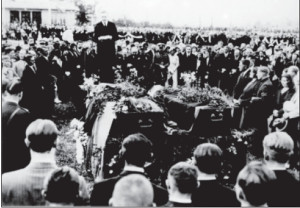
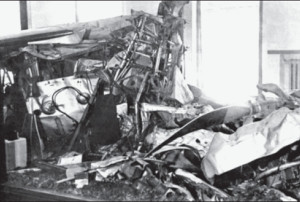
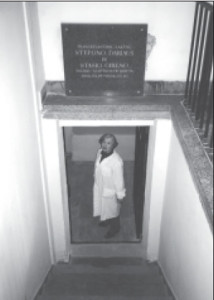
The examination rejected all rumors that Darius and Girėnas were shot by the Germans, though the reasons for the catastrophe are not clear, if it was the storm, malfunction of the plane, or exhaustion of the pilots.”
This signed statement by Dr. Oželis must lay to rest, once and for all, the rumors that were being spread throughout Europe and the United States that the Nazis shot down the airplane.
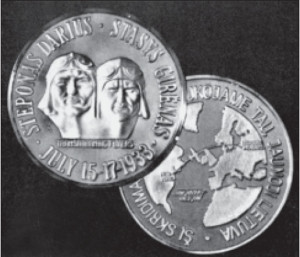
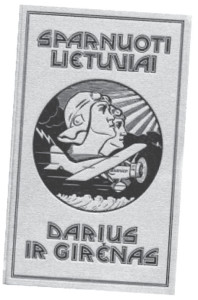
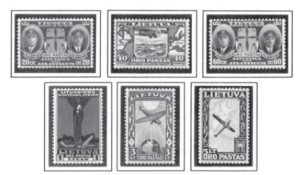
The other board of inquiry consisted of high-ranking Lithuanian Air Force Officers, and their close examination of the wreckage and the various airplane and engine components concluded that the disaster occurred due to difficult weather conditions combined with some defects in engine operation. No parts of the airplane had any signs of being shot at.
The possibility of fatigue cannot be dismissed. How well rested were the two pilots? Let’s back track, for a moment, to the morning and late evening of June 14, the day before takeoff, and notice how much activity they were involved in during the entire 24-hour period.
How much sleep could they possibly have had before the flight? Then they sat for more than 37 hours in a cramped and noisy airplane, watching the flight instruments and gauges. They had to be mentally alert the entire flight; and to make matters worse, flying in thunderstorms was stressful and tiring enough.
The courage and determination to fly non-stop to Lithuania, regardless of the dangers involved, made Darius and Girėnas national heroes and set an example for the youth of Lithuania to follow.
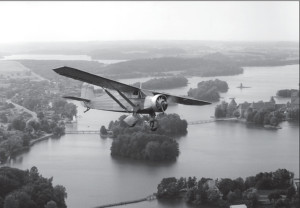
 DRAUGAS NEWS Lithuanian World Wide News in English
DRAUGAS NEWS Lithuanian World Wide News in English
